Everyone stationed behind the two-way mirror was sick, remembers Stephanie Pace Brown, president and CEO of the Explore Asheville Convention & Visitors Bureau. In January, she and her team journeyed to Washington, D.C., Cincinnati and Atlanta to gather specific insights on the traveling habits of millennials and baby boomers. Along with runny noses, the team was loaded with laptops and notepads to feverishly jot down any pertinent information provided by those on the other side of the glass.
Participants in all six focus groups had been recruited to discuss leisure travel; they didn’t know that Asheville was the target. Accordingly, the conversations were initially more generic: What locations have you visited by car in the last year? Where are some places you’d like to visit in the coming year? What factors play into your decision-making? What inspires you to seek out a destination?
Meanwhile, in between the sneezes and coughing fits, those huddled behind the mirror were busy scribbling notes.
Next, the conversation turned to print advertisements. Asheville was in the mix, but so were other destinations: Charleston, S.C.; Key West, Fla.; and Salt Lake City. Participants scanned the sample ads presented, offering feedback and critiques. Later, they viewed commercials that prompted similar discussions. Eventually, the groups’ real intention was revealed, followed by further in-depth conversations about Asheville.
Those January visits turned into February findings presented to the Buncombe County Tourism Development Authority’s board; Explore Asheville, a nonprofit corporation, was formed by the TDA to advance its goals. Some of the information presented triggered immediate action, such as replacing single-image, full-page ads with mixed-imagery layouts. The Authority also assessed other, more nuanced aspects, including specific distinctions among the three markets and two age groups, and filed away the conclusions as grist for future marketing decisions.
These qualitative findings, paired with broader, quantitative surveys, support Explore Asheville’s ongoing quest to better understand its expanding roster of target markets. Because while Asheville’s total visitation numbers continue to rise, so do those of other destinations that are competing for the same tourist dollars. And with over 90 hotels in the county now and more on the way, the need to keep ramping up demand in the local tourism industry means there’s no rest for the weary — or for those fighting winter colds.
The holy grail
Since 1983, the local occupancy tax has funded the TDA’s marketing efforts. It began as a 2 percent charge tacked onto room sales at all lodging facilities; over time, the rate has gradually increased. In 2015, it jumped from 4 to 6 percent, with 1.5 percent dedicated to the agency’s Tourism Product Development Fund. Guests at hotels, bed-and-breakfasts, vacation rentals and, more recently, Airbnbs, all pay this tax. In the fiscal year ending last June 30, the tax brought in more than $20 million, and as of the first half of the current fiscal year, those revenues were up about 5 percent.
“We are agnostic on lodging choice,” notes Brown. “But we have to be able to plan and do some revenue projections for our budget, to help understand the dynamics of what’s influencing rates.”
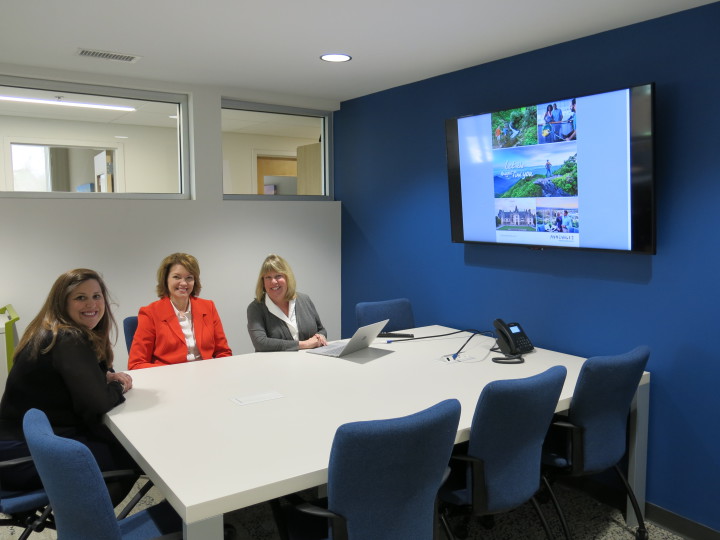
As hotels continue to sprout up downtown, the potential damage done by a room surplus — which could trigger lower average rates — also grows. A drop in Explore Asheville’s annual budget would hinder its ability to reach the very tourists needed to fill those rooms. So while the organization makes a point of not promoting individual lodgings, it clearly has a stake in keeping higher-end rooms, in particular, occupied at competitive rates, and this is reflected in the type of clientele targeted by the marketing efforts.
Explore Asheville’s 2017-18 sales and marketing plan cites “elite empty nesters” as the nonprofit’s primary demographic. The report describes this segment as “prosperous, established … couples living sophisticated lifestyles with a taste for the finer things in life.” Secondary targets include “power families,” “experiential millennials,” “bargain-seeking retirees,” engaged couples and meeting planners.
Among the many advantages offered by elite empty nesters is the potential for longer, nonweekend stays, when hotel occupancy is typically lower. “The holy grail of targeted marketing is getting people who will travel midweek,” Brown explains.
And a lot of those folks are baby boomers, notes Marla Tambellini, the organization’s deputy director and vice president of marketing. Research, she says, shows that “Boomers are traveling more right now,” and they “have much more flexibility in their travel, much more discretionary income.”
Experience vs. stuff
Still, as the recent focus groups and secondary targets suggest, other segments also factor into Explore Asheville’s marketing approach. And while decades divide baby boomers and millennials, what those groups have in common is a desire for new experiences, notes marketing consultant Chris Cavanaugh, who founded the Asheville-based Magellan Strategy Group.
“Baby boomers generally have all the stuff they want,” he says. “They don’t need any more stuff; they want to travel. Millennials, generally, haven’t shown much interest in getting stuff, but they have certainly shown an interest in experiences and travel.”
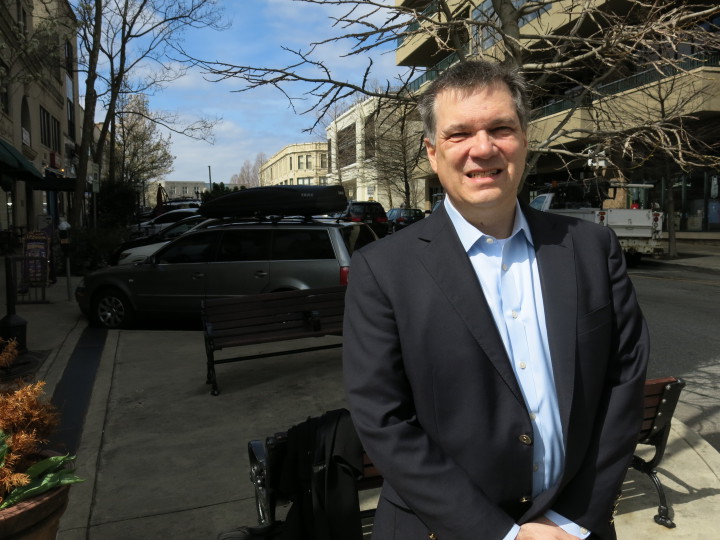
Therefore, says Tambellini, Asheville’s message “doesn’t change drastically” from group to group. Nuances may exist — beer, for example, might be more heavily featured in ads targeting a younger audience — but the core theme of discovery remains the same.
What has changed and continues to evolve, however, is how that message is delivered. In Tambellini’s early years in marketing, she recalls, it was mostly 800-numbers and print ads. These days, the options seem limitless: television, radio, Hulu, YouTube, Facebook, Instagram. And while the internet makes it easier to reach a broader audience, it also makes those folks aware of a lot more potential destinations.
“One of the challenges we have as marketers is ensuring that we understand how our different channels sync up and which channels are supporting other channels,” notes Tambellini. “For example, you want to have your television out there, but then you have that layer of digital. And it’s those things that we’re constantly trying to improve and update, to ensure that we have the best marketing mix that is not only effective but efficient.”
Choose your own adventure
In 2016, Explore Asheville hired Longwoods International to compile a visitor profile. The firm, which has offices throughout the U.S. and in Toronto, bases its findings on annual surveys conducted nationwide. “Participants are telling us about their travels — everything from the tools they used to plan their trips to the experiences they engaged in during their travels,” company President Amir Eylon explains.
This data, he continues, “is overlaid with all the psychographic and demographic information.” From the size of the party to the type of getaway, Longwoods gave Explore Asheville specific breakdowns on who was visiting the city, why and for how long.
One key finding was that most visitors to Asheville were daytrippers: Only 34 percent stayed overnight, and 58 percent of those who did said they’d been influenced by marketing efforts. Overall, the top five activities cited by those overnight visitors were shopping, visiting a landmark or historic site, eating out at fine dining establishments, visiting national or state parks and hiking or backpacking.
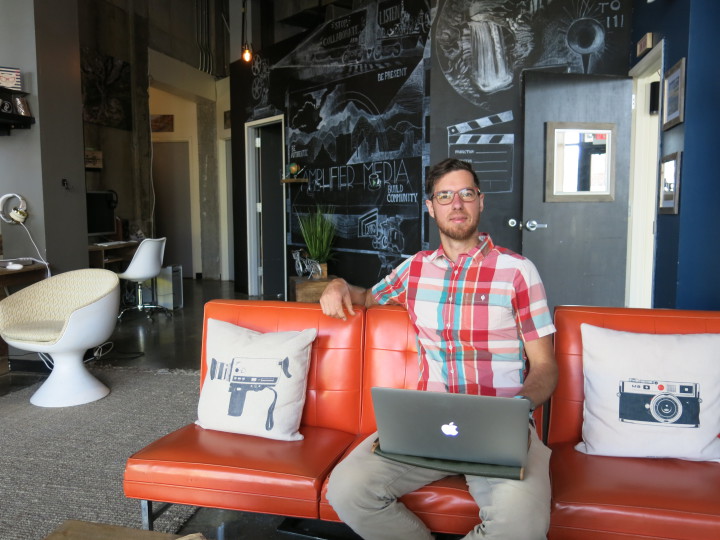
Not surprisingly, that information has made its way into Asheville’s marketing campaigns: Visitors holding shopping bags are shown strolling down Wall Street or cruising through a local market; time-lapse videos capture clouds rolling in over the mountains; shots of Biltmore Estate flash across the screen; backpackers wander among blooming rhododendrons; revelers patronize rooftop bars overlooking downtown.
Since 2012, Jared Kay has been the eye behind the lens for many of those commercials. Kay, who founded the locally based videography and photography firm Amplified Media, says, “Asheville is funny, because I think Asheville is no longer just Asheville. Some cities, you fly in and you’re there. But when you arrive in Asheville you can kind of choose your own adventure.”
That’s a key distinction for marketing the area, notes Brown. “We’re a county-level organization: We’re promoting experiences throughout Buncombe.” Encouraging visitors to venture beyond downtown’s boundaries and the city limits, she says, may lay the groundwork for additional overnight stays and repeat visits — while helping dilute the impact of tourism and perhaps defusing some of locals’ complaints.
Mixed blessing?
Drive through Asheville with out-of-state plates and you may catch a few nasty looks. Issues connected to tourism raised by residents in online comments and platforms include traffic congestion, overcrowding, environmental concerns, low-wage jobs associated with the hospitality industry and a lack of affordable housing attributed, in part, to visitors-turned-vacation-homebuyers.
Yet “An Assessment of Impacts of Buncombe County Tourism,” a 2017 report by the Magellan Group, presents data showing consistent or even, in some cases, lower traffic volumes in 2016 compared with prior years. It also emphasizes the estimated $202.5 million in state and local taxes generated by the tourism industry in 2016, as well as the $1.7 billion in direct visitor expenditures in 2014 (with a projected jump to $2.1 billion by 2020).
In addition, says Cavanaugh, his company’s report underscores one of the less recognized aspects of the local tourism industry: “the number of small businesses in this town that are supported by it.” The assessment notes that 90 percent of Explore Asheville’s tourism partners are small, independent and locally owned.
Nonetheless, local hostility toward the industry is palpable. On a recent downtown shoot, Kay spent part of the day filming foot traffic on Wall Street. “I was going past Laughing Seed, and there were people sitting out front and it was a beautiful day,” he remembers.
But once Kay took the footage back to his River Arts District studio, video editor Emily Lynes Green pointed out a glaring oversight on Kay’s part. “There was a guy literally covering his face with his hand and middle finger,” he recalls with a laugh. “We probably would have used it if Emily hadn’t noticed. Could you imagine? An ad with some random guy giving you the bird?”
Preserving core values
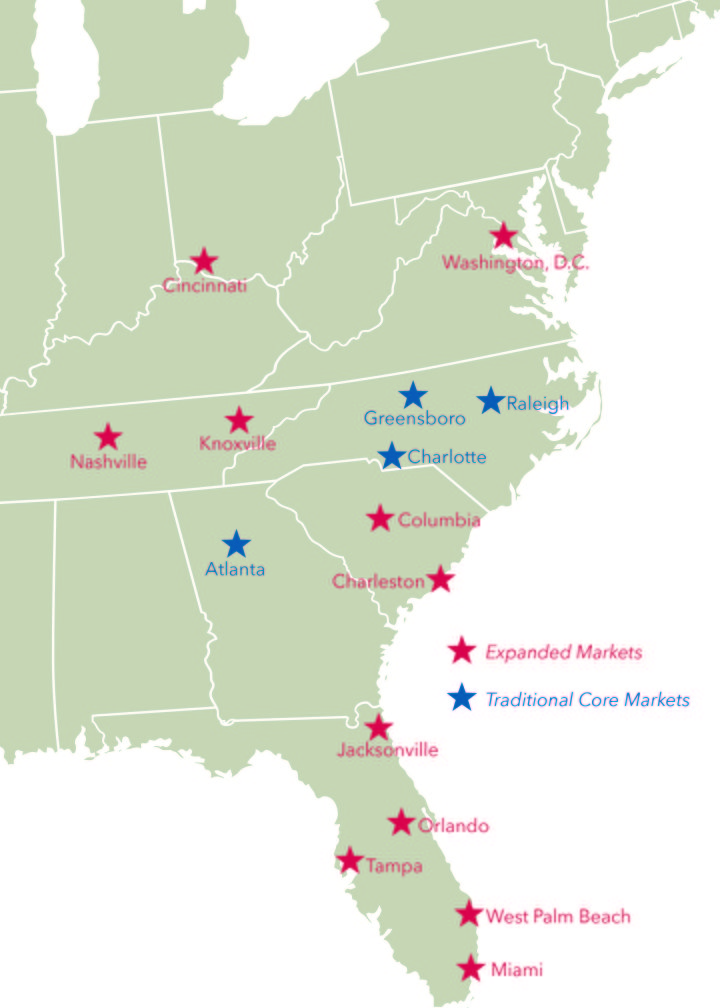
Explore Asheville’s 2017-18 sales and marketing plan sets some ambitious targets: 4.7 million visits to exploreasheville.com, 3 billion “earned media impressions” (unpaid coverage resulting from public relations outreach efforts) and over 750,000 views of the organization’s videos. Other goals include turning more daytrips into overnight visits and encouraging tourists to visit year-round.
“We now have a much bigger, broader brand awareness for visiting Asheville,” says Brown. This is evident in the presentation slides from the TDA’s 2017 annual meeting in September. A map of the Southeast highlighted the city’s expanding reach. Greensboro, Raleigh, Charlotte and Atlanta have long been Asheville’s core markets, but there are now 15, including locations in Florida, South Carolina and Tennessee, plus Cincinnati and Washington, D.C.
“Every place is growing or declining,” says Brown. “I just don’t think places really tread water. … What’s important to Asheville’s growth is that we grow smartly and authentically and that growth, as much as possible, doesn’t change the characteristics that the community values.
The future is now
HGTV, The Weather Channel and Travel Channel are the most recent additions to Explore Asheville’s media arsenal; television ads will air on these outlets throughout the spring, amounting to $5.8 million in total advertising costs. “That will give us a national reach in a consolidated time period,” says Tambellini.
These latest placements mark the organization’s largest paid media campaign to date. According to the research company SMARI, which recently conducted an ad-effectiveness study for the TDA, the concerted effort will inject an estimated $250 million into the local economy.
“It’s like leapfrog,” adds Brown. “You leap over one barrier and then you go on to the next one.”
Meanwhile, however, the same thing is happening across the state, region, country and world. “When you’re in a very highly competitive marketing place, and as more and more destinations are investing in telling their story, you have to be consistent,” says Eylon. “It’s about frequency and reach.”
But in order to remain competitive and sustain growth, Cavanaugh maintains, tourism marketing must also keep an eye on the future. “A lot of what I have done, not only for Asheville but for other destinations as well, is to look at what’s next,” he reveals. “As Wayne Gretzky once said, ‘Skate to where the puck is going to be, not where it is now.’”



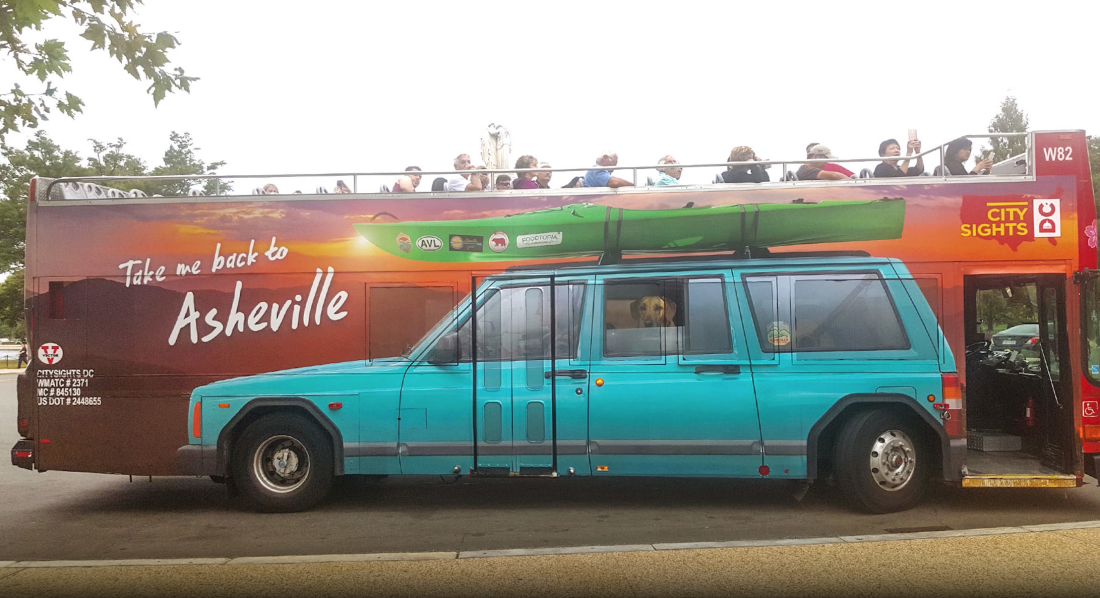
Charlie Brown sigh.
Yay, more tourists.
And again the Mtn X kow-tows for coverage.
Thomas Malthus had a theory of a carrying capacity,
but never mind. Let’s just kill the golden goose for lack of
the S word. Sustainable.
Lawdy Lawd knows I have tried to warn us for numerous posts.
How is it kowtowing to pull back the curtain on the actual activities involved in the tourism industry’s promotion of Asheville?
By playing the rah rah cheerleader for it every single issue without giving equal coverage to skirting the razor’s edge of Malthusian economics.
Just saying.
PS finally someone looked up kowtowing!
Kiss your Asheville goodbye.
I do not agree with your characterization of our coverage.
But checking back, I see that you are very familiar with it and have raised similar concerns in your comments on previous articles (including kowtowing, which I don’t need to look up, thankyouverymuch).
Maybe you can point us toward a source who could provide a substantive critique of the local tourism industry as well as data.
If anyone thinks tourism is a particular boon to Xpress, they are mistaken.
I appreciate your interest in this topic and I assure you that I have indeed kissed the former Asheville goodbye. That doesn’t mean I’m not committed to the present one.
LOL you kissed it goodbye? You weren’t here to ever get to know it. None of you were.
Untrue. I grew up in Hendersonville and spent a lot of time in Asheville as a child, teen and young adult before moving to Boston in 1994. Moved back to Asheville in 2005.
I’m not claiming to be a longtime Asheville resident but I have watched its shifts over the last 40 years.
Please enjoy those rose colored glasses.
My point exactly. Rose colored glasses lulz? Oddly enough I don’t recall traffic jams, egotistical morons, elitist scumbags, and the fake vibe of today. Ooh downtown is booming I hear. Too bad the locals, and I mean the real locals and not these pukes that move here from their overtaxed more than Asheville enclaves, are disgusted by it. And the irony of it all, have been pushed out as well LOL. Downtown is not for locals except if they work the low wage jobs or pay for it through taxes. It does nothing except lower the quality of life of the area.
Thanks for pulling back the veil on all this. In regards to “Preserving Core Values” I think Explore Asheville is dead on. “What’s important to Asheville’s growth is that we grow smartly and authentically and that growth, as much as possible, doesn’t change the characteristics that the community values.” Hey, has anyone ever mentioned that there’s not a single person-of-color on the Explore Asheville contact page of their website? I presume it’s the same in the actual office. Twenty-five white people. Twenty million bucks. Core Values represented? Check!
https://www.ashevillecvb.com/contact-us-2/
LOL stop with the race cause that’s getting stale.
You live in white bread west Asheville? Why? Some of the biggest phonies around are also some of the biggest finger pointers.
‘white bread west asheville ? are you kidding ? ? ? anything but …
philipino, ukrainian, elsalvadoran,african, etc, over here every day…
Back in 2016 City Council approved of plans by John McKibbon to turn the BB&T building into a hotel (with some condos and retail stores in the mix.)
Among the things Mr. McKibbon promised in an effort to win council’s approval was his work and advocacy to get a portion of the hotel room tax, which currently goes solely to the TDA for the promotion of tourism in Asheville, to go directly to the city to help pay for services used by tourists — something the TDA has fought tooth and nail against (and then wonders why they have such a negative local image.)
More than two years later there has been no word on what Mr. McKibbon has done to make good on this promise. Perhaps MX could do some reporting on this in addition to this puff piece for the TDA that limits any criticism of this locally controversial organization, to a brief mention of its local unpopularity nearly 30 paragraphs in. This is more of the type of hagiograph of TDA/Chamber of Commerce one expects from the Citizen-Times, not from WNC’s “alternative” weekly.
Thanks for the comment. Early in the article I note the Tourism Product Development Fund. I don’t expand on it in the piece, because that wasn’t the focus of my article. Had I devoted attention to it in this article, I might agree with your characterization of the work as a “puff piece.” Feel free to look up the Tourism Product Development Fund. I would include a link, but I wouldn’t want it misinterpreted as me promoting the TDA. However, based on my conversation with the organization, I can tell you this would be their response to your criticism.
We have regular local government coverage that reports on the TDA as it relates to the city, funding, development projects, criticism of the organization, et cetera. That was not the focus of this piece.
I think we understand that the focus of the piece was translating the 2017-18 sales & marketing plan from marketese to plain English.
https://www.ashevillecvb.com/wp-content/uploads/SalesMarketingPlan17-18_FINAL_forweb.pdf
The piece also touched upon something useful: that the TDA’s budget is, for better or worse, bound up with the average room rate, and while the official posture is “agnostic” towards lodging choice, the marketing effort is not. One thing that can also be done digitally (though not in print) is to show the TV ads that sell Asheville to viewers in places like DC and Florida but aren’t as visible to locals:
https://www.youtube.com/user/exploreasheville/videos
”
“PRIMARY AUDIENCE
Elite Empty Nesters: Prosperous, established empty nesting couples living sophisticated lifestyles
with a taste for the finer things in life; embrace new and exciting cultural experiences; enjoy trying
different types of food; very interested in the fine arts; active in philanthropic and charitable
ventures; want to explore and learn new things; relish the opportunity to travel far and wide;
frequently travel to both domestic and foreign destinations.”
I for one love what Asheville has become. I’ve been here for 42 years, and I’m SO GLAD it’s no longer an art town. I love the breweries and wonderful award winning culinary choices. I was getting so sick of all the potters, painters and fiber artists whining about not being appreciated and wanting free space to “create”. I also think tourism is a wonderful industry for Asheville. It works for a place that can’t compete with the Charlottes, Atlantas and even Greenvilles of the area.
Downtown Greenville is modern. And they didn’t construct it around tourism. It’s an actual business hub. Here it’s the opposite with residents financing it and businesses taking all the money. While providing low pay jobs.
Idk why they’re flying all over the place. Just drive down the road to Greenville SC and ask them what they did. They were dead and dying, and then they demoed bridges and overpasses, built Reedy River park, along with a few other choices advancements, now their downtown area is thriving, and Greenville as a whole is better for it. On visiting Asheville, I see the French Broad winding it’s way through the heart of the city, but isn’t really made a center piece. Living in FL I know one thing, water is a key drawing point. Just a thought.
LOL except here the cost overruns on top of being in a flood plain will show that line of thinking isn’t applicable everywhere. All it takes is a solid week of heavy rain and all that fluff gets washed away. And recovery will of course be put on the backs of taxpayers.
huh? you need to rethink your mistaken interpretation….how many millions are being spent here on the river now ? ? ?
???
Can you translate that into Standard American English please?
“Asheville should be more like Greenville by not doing some of the things that Greenville has done.”
It’s apples and oranges, of course, especially if you pay attention to a) 120 years of history; b) where people actually live in the GSP area; c) the missing southwest quadrant of Asheville.
My point was instead of the expenditures of traveling all over the country to assess what very large cities do, it would more cost effective (and make more sense in my estimation) to just drive down the road and pull a page out of somewhere like Greenville’s playbook; a city of a “more comparable” size. This doesn’t mean that they would have to do the same things with the river as Greenville did: the point was that they took something that had been over looked and unused (i.e. old textile mills, river and falls that were covered up by an overpass.) and made a few big changes and utilized what they had. However, since I do not live in Asheville yet, I apologize for throwing words into a conversation I apparently underestimated the complexity of. (Hopefully that was clear enough American English) :) :D
Hey Lulz…Thumbs up! Don’t stop with the on target critiques. Unrelenting stupidity and lack of foresight make the “insane gene” theory more believable. I thought perhaps this city would be different. Not so.